You have /5 articles left.
Sign up for a free account or log in.
Antosha & Levitasha: The Shared Lives and Art of Anton Chekhov and Isaac Levitan. Serge Gregory. Northern Illinois University Press, December 2015. $39, paper.
The University of Illinois’ slide library was a quiet, comfortable room, usually empty except for a librarian and maybe one other patron. Flipping through file drawers of individual works by world artists from all periods was a pleasant way to spend an afternoon. I’d make two- or three-dozen selections and check out the slides in plastic sleeves, arrange them at home in a projector carousel, and show them to students to illustrate the affinities of specific writers and artists. Sometimes this involved actual friendships and shared ideas, as with Zola and Cezanne, or Stein and Picasso. Other times there were important similarities in tone or subject, such as the portrayal of landscapes by Washington Irving and the Hudson River School, or the feeling of troubled minds in Poe and Goya. There was something to be compared in a short story by Ambrose Bierce, Civil War photos of Alexander Gardner, and a Cannes-winning French film made from the story. Hemingway famously said he owed a large debt to Cezanne, and as scholar Monika Gehlawat says, “Hemingway does not decide to write as Cézanne paints simply because he fancies the painter’s handiwork, but because he requires it to tell [a] story and imbue it with a particular psychic context.”
Chekhov is a literary Impressionist; his fictional world often takes on the shape and colors of his protagonists’ emotions, but underneath he’s harder and more Modern than Monet. I had no familiarity with Russian painters of his time, except for Repin, who sometimes shows a Chekhovian clarity but can also be like idealized Courbet. As I flipped through slides of late nineteenth-century Russian paintings and held them to the light, Isaac Levitan (1860-1900) seemed the closest visual equivalent to Chekhov. It was a lucky find. Until I read an entry on Levitan in an art encyclopedia, I knew only they were contemporaries.
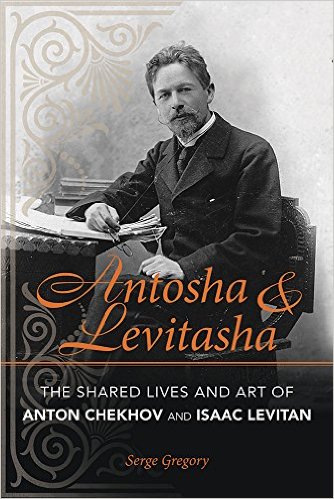 Now, with the publication of Serge Gregory’s Antosha & Levitasha, we have the first biography of Isaac Levitan in English, as well as the biography of an important artistic friendship. Gregory, who has a Ph.D. in Russian Language and Literature, has worked as a corporate writer, filmmaker, and independent scholar. Interestingly, he is also the great-grandson of Chekhov’s closest neighbor when he lived at Melikhovo, south of Moscow. This is his first book, and it’s very compelling, especially for those interested in artistic friendships that amount to a kind of osmotic collaboration.
Now, with the publication of Serge Gregory’s Antosha & Levitasha, we have the first biography of Isaac Levitan in English, as well as the biography of an important artistic friendship. Gregory, who has a Ph.D. in Russian Language and Literature, has worked as a corporate writer, filmmaker, and independent scholar. Interestingly, he is also the great-grandson of Chekhov’s closest neighbor when he lived at Melikhovo, south of Moscow. This is his first book, and it’s very compelling, especially for those interested in artistic friendships that amount to a kind of osmotic collaboration.
Anton Chekhov and Isaac Levitan were born in the same year. Both had lower-class childhoods and fathers who were less than successful, creating hardship for their families. They came to know many of the same people in artistic and aristocratic circles in Russia and abroad, and were tied by common jealousies. Levitan never married; Chekhov only did near the end of his life and was often apart from his wife. (Chekhov: “Medicine is my lawful wife, and literature is my mistress.” Levitan to Chekhov: “I would like to get legally married to my muse, but she, nasty lady, doesn’t want to!”)
Both men began to succeed financially about the same time (1886) and were eventually recognized as major artists. Both had a “sensitivity to nature and an awareness of its power, its vulnerabilities to human depredations, and its indifference to human hopes and desires,” as Gregory says of Chekhov. “To those who have seen Levitan’s paintings and read Chekhov’s works, it is evident that Levitan’s ‘landscapes of mood’ have much in common with the way that Chekhov’s characters perceive nature as a reflection of their emotional states.”
That awareness had its cost for both, I believe. Gregory says: “When nature failed to provide Levitan with artistic inspiration...what remained was a sense of lonely isolation, a terrifying awareness of the indifference of geological time to the pitifully unimportant life of any individual.” Compare that with Nina’s scene-setting in Chekhov’s Seagull: [A]ll life, completing the dreary round imposed upon it, has died out at last. A thousand years have passed since the earth last bore a living creature on her breast, and the unhappy moon now lights her lamp in vain. No longer are the cries of storks heard in the meadows, or the drone of beetles in the groves of limes. All is cold, cold. All is void, void, void. All is terrible, terrible—“
Gregory says, “For Levitan...recognition of the divine in nature evolved and eventually formed the core of his aesthetic beliefs, which reflected an animistic sensibility rather than devotion to any particular religion.” This became an existential view for both artists. Levitan wrote to Elena Karzinkina, a younger painter with whom he was in love: “Are you too not struck by the conditional nature and futility of attempts to understand what’s around us? We’re given nothing besides the opportunity to question, question, and question[...]. How awful!” Similarly, Chekhov wrote, “All of life and human relations have become so incomprehensibly complex that, when you think about it, it becomes terrifying and your heart stands still.”
Both men died young, of disease—Chekhov of tuberculosis; Levitan, Gregory believes, of complications from syphilis—four years apart.
Oddly, since the power in the relationship resided mostly in Chekhov, “Levitan had a much greater influence on Chekhov’s writing than Chekhov had on Levitan’s painting,” Gregory says. Chekhov learned from Levitan to “use landscape as a metaphor for the emotional state of his characters,” and Levitan was a character source for more than one story and for The Seagull.
***
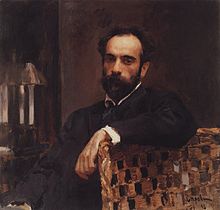 Levitan was born in what is now Lithuania, in the Pale of Settlement. His father came from a rabbinical family but was secular, knew several languages, and worked as a tutor, translator, and for the railroad. He enrolled his son in the Moscow School of Painting at 13, where the boy often went hungry and had to sleep secretly in the school. Chekhov’s Orthodox father was a shopkeeper and a bankrupt, and Anton struggled to complete his education and had to help support his family the rest of his life. Both sons experienced deprivation when their families did not thrive.
Levitan was born in what is now Lithuania, in the Pale of Settlement. His father came from a rabbinical family but was secular, knew several languages, and worked as a tutor, translator, and for the railroad. He enrolled his son in the Moscow School of Painting at 13, where the boy often went hungry and had to sleep secretly in the school. Chekhov’s Orthodox father was a shopkeeper and a bankrupt, and Anton struggled to complete his education and had to help support his family the rest of his life. Both sons experienced deprivation when their families did not thrive.
Gregory says Chekhov and Levitan met in the early 1880s, sharing a circle of friends who were students, artists, writers, publishers, and brothel-goers. Chekhov’s brother Nikolai, also an artist and failed student, lived in Levitan’s building, and introduced their sister, Maria, to Levitan. They all became close friends. A journalist of the time who knew them said it was lucky for Levitan to be accepted into the family: “’Levitan was poor, but he tried as much as possible to dress nicely so as to fit into the Chekhov circle, which at that time was also poor, but also talented and jolly.’”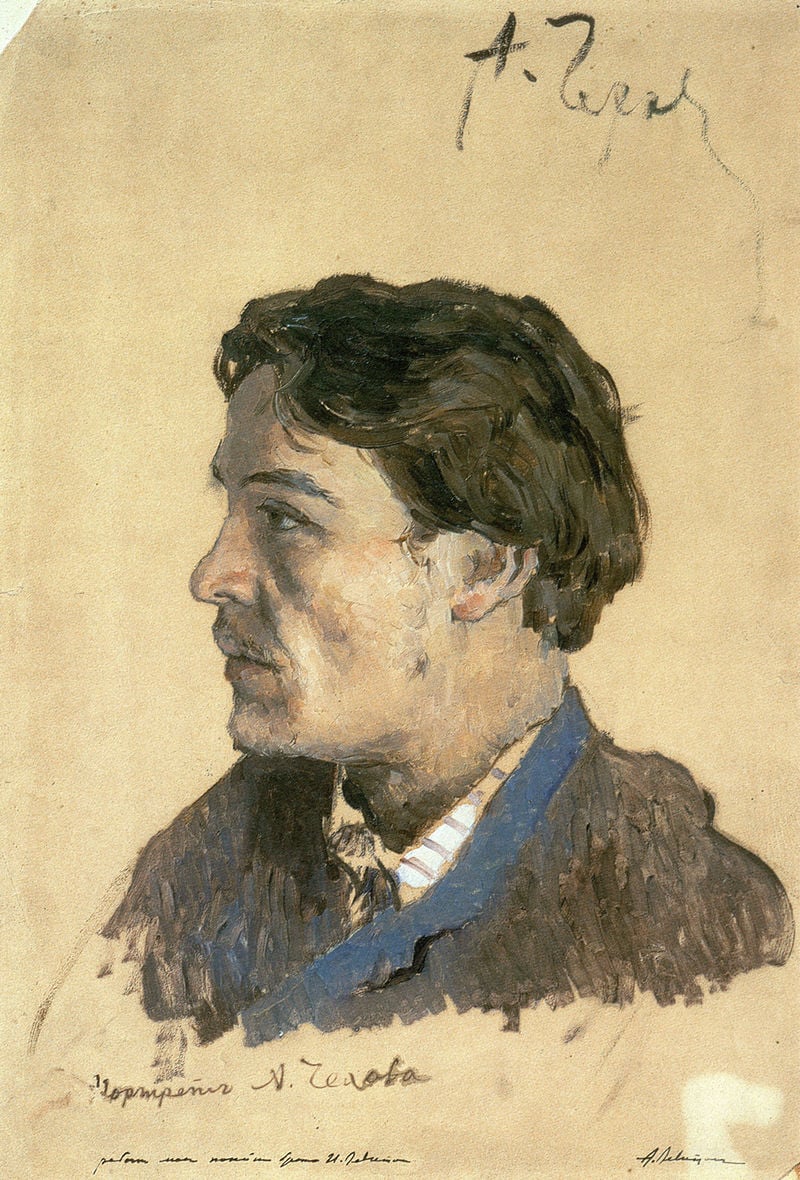
In time Levitan believed he and Chekhov had similar ambitions, which were spiritual. He told a friend, “When my sister says, ‘Why do you paint a gray day or a muddy road?’ I say nothing. But if a woman I loved said this, my woman, I would leave her right away. [...] You don’t understand. But you just wait, you will. My sketch, this tone, this blue road, this sadness in the shaft of light beyond the forest, this is me, my spirit. It’s in me. And if she doesn’t see this, doesn’t feel it, then who are we? Strangers. What will I talk to her about? Antosha understands this. He alone isn’t falling in love all the time like you are.”
But Levitan and Chekhov had very different personalities. “Chekhov was always ironic and diffident, Levitan highly emotional and quick to take offense,” Gregory says. Levitan is shown trying to dash into marriages, often kneeling in dusty roads to declare his love to women he hasn’t developed adequate relationships with, such as Maria Chekhova, who was shocked and turned him down. Chekhov was always running from marriage, making light of love, coolly, sometimes cruelly, in his correspondence and conversations. (Scholarship over the last hundred years has definitively overturned the notion of Chekhov as some saintly abstinent ascetic. This book has too many implications of both men’s sexual lives to tally here; even a rumor of “orgy” is mentioned. It was only by the grace of someone's animistic sensibility that Chekhov did not also contract syphylis.)
Chekhov, maybe our most most famous sick writer, worked under the death sentence of TB but almost always appeared cordial, calm, and collected. Gregory diagnoses Levitan with “a form of bipolar disorder” due to his “mood swings...between low self-esteem and grandiose overconfidence...uninhibited people-seeking and introverted self-absorption...apathy and sharpened creative thinking...[and] periods of hypersexuality.” He was not easy company, and Chekhov sometimes ignored his letters, even when he was pleading for help.
Anti-Semitism also entered Chekhov and Levitan’s friendship, but it’s hard to tell how much it affected it. Gregory foregrounds the issue by making a collage of ethnic-religious slurs directed at Levitan by Chekhov in letters and in “vaudeville” skits and pranks that Chekhov and friends, including Levitan, participated in. But Gregory adds, “Chekhov’s behavior was more callow than intentionally cruel and fit into the general atmosphere of playful mockery of the outside world that presided....” He points out that while Chekhov “matter-of-factly called his friend Levitan a ‘yid’ (‘zhid’)...[i]n other contexts—in his stories and his letters to professional acquaintances—he used the neutral word ‘evrei’ when mentioning Jews.”
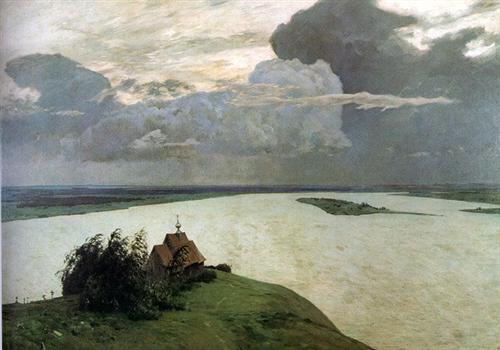 Gregory concludes, “There is a parallel between [Chekhov’s] contradictory portraits of Jewish women [as in the story “Mire” and the play Ivanov]...and the contradiction inherent in Chekhov’s relationship with Levitan.”
Gregory concludes, “There is a parallel between [Chekhov’s] contradictory portraits of Jewish women [as in the story “Mire” and the play Ivanov]...and the contradiction inherent in Chekhov’s relationship with Levitan.”
“Levitan himself seemed unperturbed by [the skits’] anti-Semitic tone,” Gregory writes. But, “However assimilationist his inclinations were, Levitan was forced to inhabit the role of the alien Jew, the interloper in Russian society.”
(In 1891, the brother of Tsar Alexander III became Governor General of Moscow and ordered the expulsion of some 38,000 Moscow Jews. Levitan was forced to rely on influential friends and patrons to plead his case—“we have only one Levitan in all of Russia”—and be allowed to stay in his Moscow lodgings. He wouldn’t receive formal permission to live outside the Pale of Settlement until 1894. Late in his short life, as Gregory shows, when questioned how a Jew [“’a member of another tribe’”] “could feel and understand Russian nature so well,” Levitan responded, “It’s possible that some of my landscapes of Russian nature came out successfully because I have had to suffer and endure many terrible things. It seems to me that a cheerful person can’t strongly feel Russian nature: in her there is so much melancholia, sad calmness, spiritual loneliness.” Gregory says, “With the self-consciousness of an assimilated Jew talking to a Russian, Levitan finished his thought, ‘Oh, we Jews—not the ones who sit on gold sacks and, with fingers covered with valuable rings, clutch the throats of the poor—we Jews certainly understand and are close to Russian nature.’”)
In 1892 Chekhov published a short story called “The Grasshopper” that contained “thinly disguised portraits” of Levitan, his married lover, and her husband. Gregory says, “[T]he people in Chekhov’s life served as raw material to be refashioned to suit the internal logic, structure, and emotional truth of a story. But inescapably, the spark that gave birth to ‘The Grasshopper’ is to be found in Chekhov’s annoyance, even jealousy, at the way Lika [Lydia Mizinova, with whom he had a relationship], Levitan, and [Levitan’s married lover] carried on and ultimately ignored him as he sat alone...in the summer of 1891.”
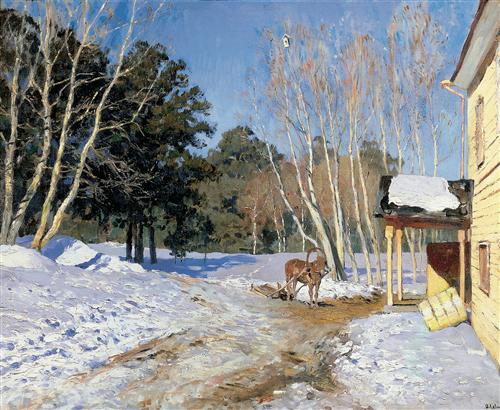 The story created a scandal and numerous rifts; two Chekhov siblings claimed Levitan was ready to duel Anton over it. In the end Levitan and Chekhov broke contact for two-and-a-half years.
The story created a scandal and numerous rifts; two Chekhov siblings claimed Levitan was ready to duel Anton over it. In the end Levitan and Chekhov broke contact for two-and-a-half years.
When they were reunited at the start of 1895—“they both flung themselves towards each other [and] very, very strongly clasped each other’s hand,” but “the friendship...was never again to be as close as it had been”—Chekhov noted that Levitan’s health had declined. Chekhov told his publisher, “He is Russia’s finest landscape painter, but, as you can imagine, he is no longer young. He no longer paints in a youthful way, but with bravura. I think women have worn him out. These wonderful creations give their love, and they don’t take much from a man—only his youth. It’s impossible to paint a landscape without pathos, without enthusiasm, and enthusiasm is impossible if a man has stuffed himself full. If I were a landscape painter, I would lead an almost ascetic life: I would have sex once a year and would eat only once a day.”
(Compare Hemingway: “I learned to understand Cézanne much better and to see truly how he made landscapes when I was hungry. I used to wonder if he were hungry too when he painted; but I thought possibly it was only that he had forgotten to eat. It was one of those unsound but illuminating thoughts you have when you have been sleepless or hungry. Later I thought Cézanne was probably hungry in a different way.”)
At the time, though, Anton, more full of crap than a Christmas goose, was having an affair with a young woman while chiding her partner for her “unabashed lesbianism,” according to Gregory.
***
Gregory has a writer’s eye. It’s difficult to write about the inanities, contradictions, and emotional largeness of small events in one life, let alone in two concurrent ones. The chapter on the period 1890-91, in which sexual rivalry began to ruin the men’s friendship, is particularly finely drawn. (Chekhov to Lika, on the flirtatious Levitan: “I hope you accidentally stab him in the eyes with a fork.”)
The book is laid out wonderfully, and Gregory’s chronological tags never fail to reinforce understanding of when we are. One drawback is that the paintings included in the middle section (in one color, understandably) are not keyed to the text. What’s more, Evening on the Volga, described here as “Levitan’s first significant painting to come out of this period [1887-89]...[is] almost three feet wide.” The reproduction is five inches wide. Readers might supplement with Isaak Levitan: Lyrical Landscape, by Averil King, or, in a pinch, see WikiArt.
Gregory’s focus throughout is masterful, though it results in odd pacing at times. I hadn’t known or remembered that Chekhov invited Levitan to accompany him on his famous trip to Sakhalin Island. Levitan declined, and since he’s the focus, Gregory sums up Chekhov’s intense three months on Sakhalin in two sentences to keep his story moving.
Gregory also sounds unsympathetic to his subjects at times, though I can’t say without good reason. On Pavel, Chekhov’s father: “an inveterate crank.” On Levitan: “characteristic overwrought emotions.” On Lika: “[She] discovered [another woman] was also pursuing Chekhov, and this prompted her to seek revenge in Potapenko’s arms. By the end of February 1894, Lika was pregnant with Potapenko’s child, a troubling development complicated by the fact that he was already married.” On Chekhov: “[E]xercising his talent demanded a ruthless appropriation of his friends’ lives.”
These sorts of phrasings create a Chekhov that is more human but less likable, perhaps more intimidating, but the impression is probably for the better. After all, Gregory says that Potapenko felt, “[I]t was not easy to feel certain that you had Chekhov’s friendship. He had the kind of irresistible charm that made people act very openly in front of him, ‘but he never revealed his soul to anyone.’”
***
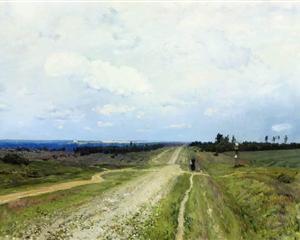 Still, Chekhov and Levitan shared half their lives and visited one another to the end. Chekhov helped diagnosis his friend with “a distended aorta [...] and a passionate thirst for life.” (Gregory diagnoses “tertiary syphilis as a probable cause,” but admits, “It is, however, possible that Levitan’s heart condition resulted from a congenital defect....”) About this time, in 1897, Chekhov had his first major hemorrhage and was admitted to a clinic for a few days.
Still, Chekhov and Levitan shared half their lives and visited one another to the end. Chekhov helped diagnosis his friend with “a distended aorta [...] and a passionate thirst for life.” (Gregory diagnoses “tertiary syphilis as a probable cause,” but admits, “It is, however, possible that Levitan’s heart condition resulted from a congenital defect....”) About this time, in 1897, Chekhov had his first major hemorrhage and was admitted to a clinic for a few days.
In his last years, Levitan had money, was considered a member of two rival schools of art, and was offered a faculty position at the Moscow School of Painting, which in 1884 had humiliatingly granted him only a second-class degree so he couldn’t teach painting, only sketching. Now he revived the studio of his mentors and took the job seriously. He sounded in his advice to students as if he was articulating both himself and Chekhov: “Search for a general tone.” “What the hell is this? [...] You’re going for cheap external effects.... No, my brother, work hard to make that which is there.... Paint simply. This is the hardest thing to do....” (Chekhov’s Note-Book: “It is unfortunate that we try to solve the simplest questions cleverly, and therefore make them unusually complicated. We should seek a simple solution.”)
Chekhov believed in Levitan’s and his own work but saw “that many young artists lacked talent and were deluding themselves”:
“If you listened to them, the future, fame, and the happiness of mankind were in their hands. And not one of them would think that this excitement was nothing but a petty, childish playing at art, that time passes, that life day by day heads toward dusk, that they’ve eaten up a lot of other people’s bread and still have nothing to show for it; that all three of them are victims of the intractable law that says that out of hundreds of beginners with high hopes, only two or three will land on their feet, the rest will fall to the wayside and become cannon fodder.”
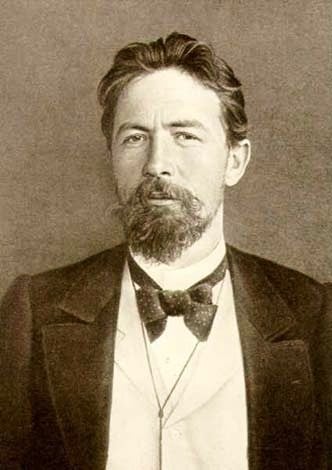 The reason for being of the book, and one of its dramatic thrills, is that these two friends not only did not fall to the wayside but have endured.
The reason for being of the book, and one of its dramatic thrills, is that these two friends not only did not fall to the wayside but have endured.
They also both pointed the way to the future. Moscow art critics said Levitan’s near-Modernist haystacks “looked like something between the shaggy coiffure of a hairdresser and a bristling porcupine,” which brings to mind the criticism that JMW Turner’s work was like “flinging a pot of paint in the public's face.” Art and the world itself were to change radically in a very short time, and there’s something almost spooky in how well Chekhov and Levitan served their time of late empire. Who knows how either would have fared through the Revolution, the wars to come, ideologies, persecutions? (Dunya Efros, a Jewish woman who broke her engagement to Chekhov because he expected her to convert, married, “left Russia after the 1917 revolution, lived in Paris, was taken from a nursing home by the Nazis, and died at the Treblinka concentration camp in 1943.”)
Levitan died in 1900 at the age of 39, demanding his windows be closed because, “The sun—it’s an illusion!” He was buried in the Jewish section of a cemetery on the western edge of Moscow. Chekhov told another writer, “He was such an enormous, unique, and original talent. There is something so fresh and strong that it should have started a revolution. Yes, Levitan died much, much too early.”
In 1904 Chekhov died in Badenweiler and was buried in Moscow’s Novodevichy Cemetery. In 1941, as Moscow “liquidated” the cemetery where Levitan was buried, Levitan was one of a few major figures moved elsewhere. He was reburied three rows from Chekhov.
All of which passes for a happy ending, in a certain artistic view, and makes this a dual biography well worth reading.
***
Images of Chekhov, Levitan, and his paintings are in the public domain, from WikiArt and Wikipedia.





